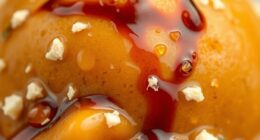Choosing between gravity-fed and pressurized soft serve machines depends on your priorities. Gravity-fed setups are cheaper upfront, easier to maintain, and ideal for small or mobile shops, but they may slow service. Pressurized systems cost more initially but offer faster dispensing, higher efficiency, and greater potential for profit, especially in high-volume venues. To maximize your earnings, consider how each fits your business goals—more details will help you decide which best supports your growth.
Key Takeaways
- Pressurized systems typically generate higher revenue due to faster service and higher customer throughput.
- Gravity-fed machines have lower initial costs, making them more accessible for small businesses with smaller profit margins.
- Long-term profitability favors pressurized units because of increased efficiency, flavor customization, and branding options.
- Utility expenses are higher for pressurized systems, impacting profit margins despite higher sales potential.
- Maintenance and durability influence consistent product quality, which is crucial for customer retention and revenue stability.
Cost Analysis: Initial Investment and Equipment Expenses

When comparing gravity-fed and pressurized soft serve systems, the initial investment and equipment costs play a significant role in your decision-making process. A thorough cost comparison shows that gravity-fed machines typically have lower equipment pricing, making them more affordable upfront. These systems usually require simpler setups, which reduces initial expenses. Additionally, lower equipment costs contribute to reduced financial risk for new businesses or startups. Moreover, the simplicity of gravity-fed systems often means less complex maintenance, further lowering ongoing operational costs. Conversely, pressurized systems often involve more complex components and advanced technology, leading to higher equipment costs. While the upfront investment for pressurized units might be steeper, they can offer long-term savings through efficiency. Additionally, filtering and pump protection can influence the longevity and performance of your equipment, impacting your long-term profitability. Proper maintenance of these components can extend equipment lifespan and ensure consistent product quality. Ultimately, your choice depends on your budget and specific needs. If minimal initial costs are a priority, gravity-fed systems are more budget-friendly. However, if you’re willing to invest more upfront for potentially better performance, pressurized options might be worth considering.
Operating Efficiency and Serving Speed

You’ll notice that dispensing speeds can vary between gravity-fed and pressurized systems, affecting how quickly you serve customers. Maintenance requirements differ too, with pressurized units often needing more attention to keep running smoothly. Additionally, operational complexity can influence how efficiently you manage your soft serve setup day-to-day. For example, Kia Tuning modifications like ECU remapping can optimize engine performance, which is analogous to fine-tuning your equipment for better efficiency.
Dispensing Speed Variations
Dispensing speed can vary markedly between gravity-fed and pressurized soft serve systems, directly impacting operational efficiency and customer service. In a pressurized system, the flow rate is typically faster and more consistent, allowing you to serve customers quickly during busy periods. Gravity-fed systems, however, tend to have a slower dispensing speed because the flow rate depends on gravity, which can fluctuate based on temperature and cone size. This variation can lead to longer wait times, especially during peak hours. If you prioritize high throughput and quick service, a pressurized system generally offers better dispensing speed. On the other hand, gravity-fed setups may work well for lower-volume operations where consistency isn’t as critical. Choosing between the two affects how smoothly your service runs and how many customers you can serve per hour.
Maintenance Requirements Differences
Maintenance requirements differ markedly between gravity-fed and pressurized soft serve systems, directly impacting their operating efficiency and serving speed. Gravity-fed machines generally have simpler designs, making cleaning protocols easier due to better component accessibility. You can quickly access parts like the hopper and dispensing mechanisms, reducing downtime. In contrast, pressurized systems often have more complex components, requiring careful disassembly for cleaning, which can slow down maintenance and affect serving speed. Regular cleaning is essential for both types to prevent clogs and guarantee quality, but the accessibility of parts influences how efficiently you can perform these tasks. Additionally, understanding maintenance protocols is crucial for ensuring longevity and optimal performance of your equipment. Proper adherence to maintenance schedules can significantly extend the lifespan of your machines. Furthermore, choosing a system with easy-to-clean parts can lead to less downtime and higher throughput during busy periods. For instance, selecting models with energy-efficient components can also reduce operational costs over time. Overall, gravity-fed systems tend to be easier and faster to maintain, keeping your machine running smoothly with less effort.
Operational Complexity Levels
Operational efficiency and serving speed vary considerably between gravity-fed and pressurized soft serve systems. Gravity-fed machines typically have simpler setup complexity, making them quicker to operate and maintain. This allows for faster flavor customization adjustments without much downtime. In addition, sound vibrations are believed to influence cellular regeneration and overall health, which can be an interesting aspect to consider when maintaining the equipment to ensure optimal performance. Proper equipment maintenance is crucial for sustaining high operational standards and preventing breakdowns. In contrast, pressurized systems often involve more complex setup procedures, which can slow down the serving process initially but offer more consistent texture and flavor delivery once running smoothly. Serving speed also depends on your staff’s familiarity with each system; gravity-fed units tend to be more straightforward, enabling faster service during busy times. Additionally, proper maintenance of the equipment can significantly influence overall operational efficiency and longevity. Overall, if quick service and ease of operation are priorities, gravity-fed systems usually outperform pressurized ones. However, the choice depends on your specific needs for flavor customization and operational simplicity.
Maintenance Requirements and Long-term Durability

While gravity-fed soft serve machines generally require less intricate maintenance, they still demand regular cleaning to prevent buildup and guarantee consistent quality. You should establish a cleaning frequency that keeps components sanitary and functioning properly, typically after each shift or daily, depending on usage. Long-term durability depends on your routine upkeep; neglecting maintenance can lead to wear and premature failure. Keep spare parts like seals and valves on hand to minimize downtime when repairs are needed. Gravity-fed machines often have fewer moving parts, which reduces the risk of mechanical problems over time. However, consistent maintenance is essential to extend their lifespan. With proper care and timely replacement of spare parts, your machine can operate reliably for years, ensuring steady revenue and customer satisfaction.
Quality and Consistency of Soft Serve Output

The quality and consistency of soft serve output are essential for customer satisfaction and repeat business. When your soft serve maintains flavor consistency, customers enjoy the same delicious taste every time, encouraging loyalty. Equipment durability plays a vital role in ensuring your machines operate smoothly, minimizing fluctuations in texture and flavor. To achieve this, consider these factors:
- Reliable temperature control for uniform freezing
- Consistent mix delivery to prevent air pockets
- Regular calibration for flavor accuracy
- Durable parts that resist wear and tear
- Proper maintenance to sustain equipment performance
- Monitoring HEPA filtration to ensure air quality standards are maintained during operation, especially in environments sensitive to allergens and airborne pollutants.
Energy Consumption and Utility Costs
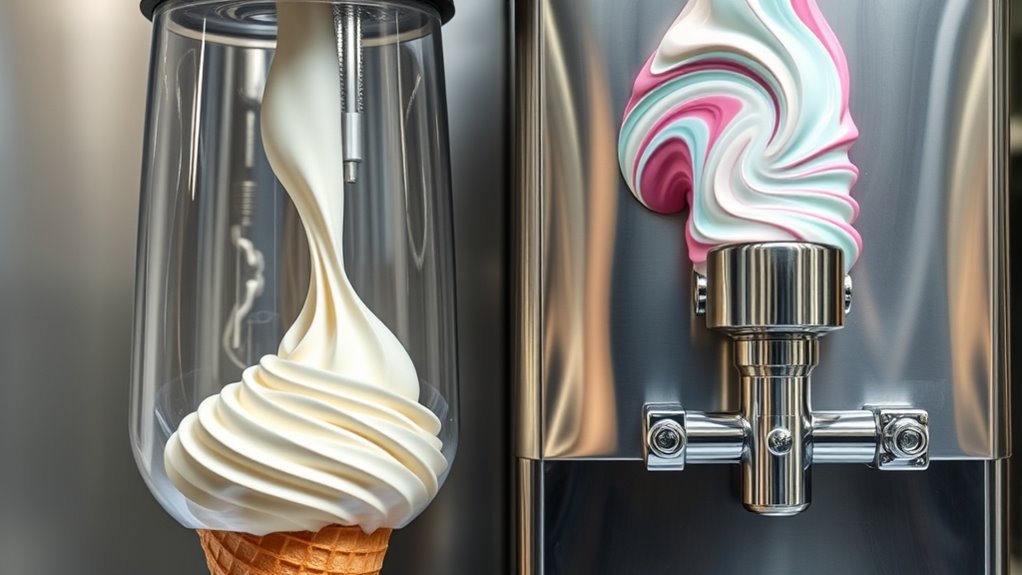
Choosing between gravity-fed and pressurized soft serve machines considerably impacts your energy bills and utility costs. Pressurized machines typically consume more energy due to their refrigeration and compressor systems, leading to higher utility expenses. Gravity-fed models often use less electricity, offering better energy savings. To help you compare, here’s a quick overview:
| Machine Type | Energy Consumption | Utility Expenses |
|---|---|---|
| Gravity-fed | Lower | Lower |
| Pressurized | Higher | Higher |
| Maintenance | Less frequent | More frequent |
| Operational Cost | Generally cheaper | Usually more costly |
Keeping energy savings in mind, choosing the right machine can substantially reduce your utility expenses over time.
Customer Experience and Satisfaction
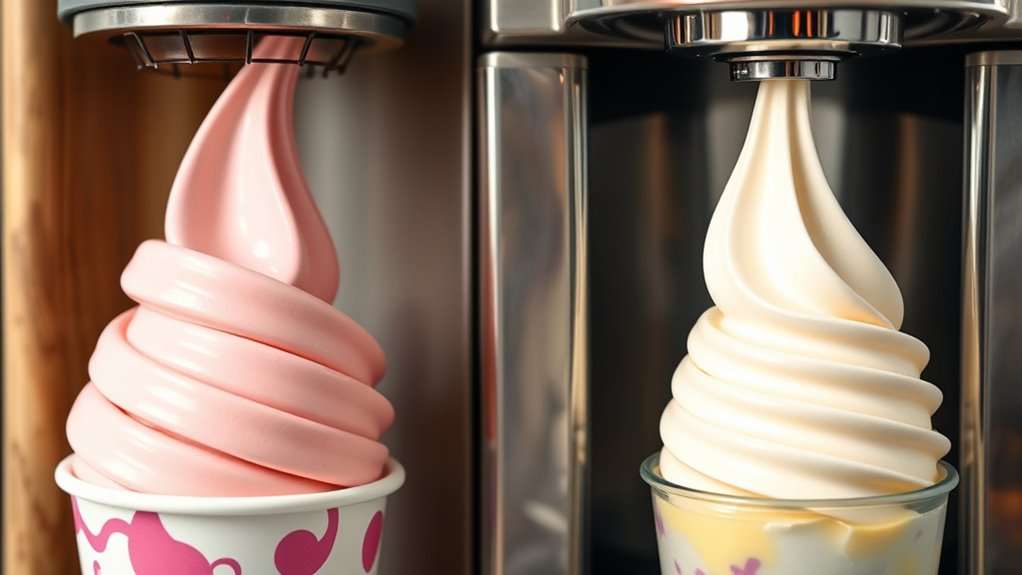
Have you ever noticed how your customers react to the soft serve they enjoy? Their satisfaction often hinges on flavor consistency and how well you meet their preferences. A pressurized system tends to deliver more consistent texture and flavor, making every cone reliably delicious. This consistency keeps customers happy and encourages repeat visits. Conversely, gravity-fed machines may fluctuate in flavor and texture, risking dissatisfaction. To improve customer experience, consider these factors:
- Smooth, uniform flavor delivery
- Quick service with minimal downtime
- Ability to customize flavors easily
- Maintaining ideal temperature and texture
- Meeting diverse customer preferences efficiently
- Additionally, understanding the importance of consistent nutrient delivery can help staff provide a more welcoming and reassuring environment, enhancing overall customer satisfaction.
Revenue Potential and Profit Margins
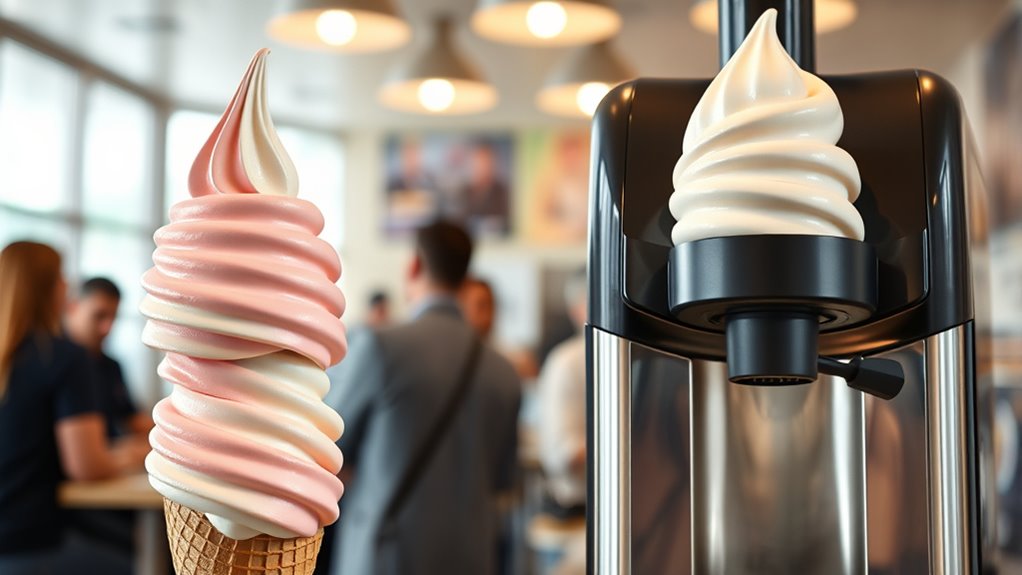
Your choice between gravity-fed and pressurized soft serve impacts your initial setup costs and ongoing expenses. These differences influence how much revenue you can generate and your profit margins over time. Understanding these factors helps you make smarter decisions to maximize your soft serve business’s financial potential. For example, selecting a more efficient dispensing system that resonates with your brand can attract more customers and boost sales. Additionally, considering vertical storage solutions can improve your overall operational efficiency and reduce clutter, contributing to better customer experience and increased sales. Incorporating secure payment processing features can also enhance transaction speed and customer trust, further supporting profitability. Moreover, evaluating how remote hackathons can foster innovative ideas for your business might provide a competitive edge.
Initial Investment Costs
While the initial investment costs for gravity-fed soft serve machines are generally lower, they often come with limited revenue potential and narrower profit margins compared to pressurized systems. With pressurized machines, you can offer more flavor customization, creating unique options that attract repeat customers. They also provide greater branding opportunities through custom flavors and packaging. Keep in mind:
- Higher upfront costs for advanced pressurized equipment
- Greater flexibility in flavor variety and seasonal offerings
- Enhanced ability to differentiate your brand
- Faster service capabilities increase sales volume
- Long-term ROI can be higher despite initial expenses, especially when considering the efficiency of pressurized systems, which can lead to improved profit margins over time. Additionally, understanding the potential regulatory considerations for each system can help avoid compliance issues and ensure smooth operation. Recognizing the importance of training and maintenance can also contribute to maximizing equipment lifespan and performance.
Ultimately, investing in pressurized systems may require a larger initial outlay, but it offers more room for growth, better profit margins, and a stronger brand presence.
Operating Expenses Variance
Because pressurized soft serve machines typically require higher initial investments, their operating expenses and revenue potential tend to differ markedly from gravity-fed systems. You’ll find that profit margins for pressurized machines can be lower initially due to higher maintenance costs and more complex staff training needs. These systems often demand specialized staff who understand the machinery, which can increase labor costs. On the other hand, gravity-fed systems usually have lower operating expenses, making their profit margins potentially more favorable over time. When comparing the two, consider that ongoing expenses like parts, repairs, and staff training will significantly impact your overall profitability. Managing these factors effectively can help maximize your profit margins, regardless of the system you choose.
Revenue Generation Potential
Pressurized soft serve machines often have greater potential for higher revenue generation due to their ability to deliver consistent, high-quality servings at faster rates. This efficiency allows you to serve more customers quickly, increasing sales volume. The enhanced flavor consistency ensures every cup meets customer expectations, boosting repeat business. Plus, pressurized systems open up branding opportunities by enabling unique flavors and custom toppings.
- Serve at a faster pace, reducing wait times
- Maintain uniform flavor, encouraging customer loyalty
- Expand menu options with specialty flavors
- Enhance branding through custom packaging and branding
- Increase profit margins with higher throughput and quality
Suitability for Different Business Models
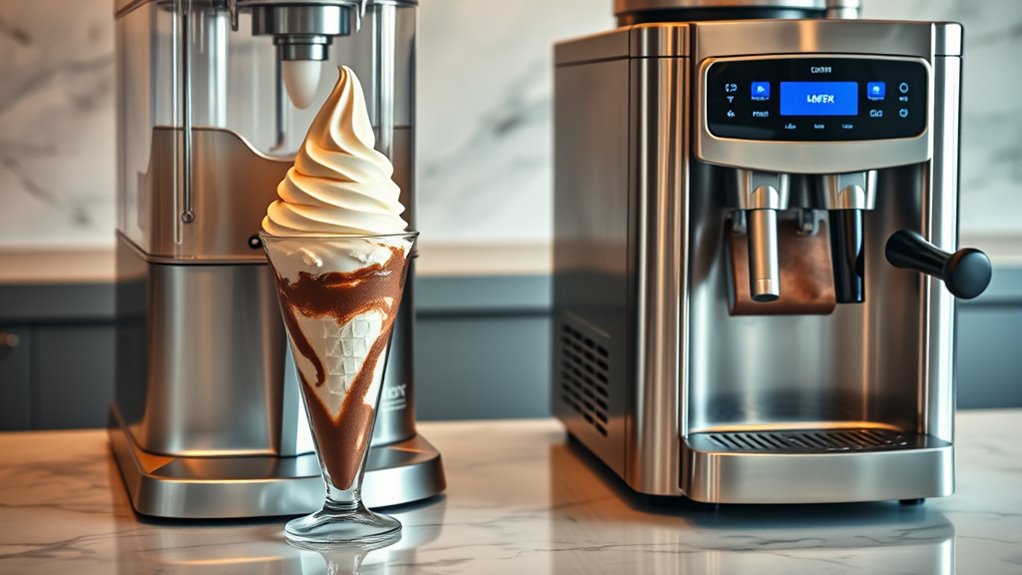
Choosing between gravity-fed and pressurized soft serve systems depends heavily on your business model. If you operate a small shop or mobile setup, gravity-fed machines offer simplicity and lower costs, making them ideal for quick service and building brand loyalty through consistent quality. Conversely, pressurized systems suit larger venues like franchise chains or high-volume locations, where you need faster service and uniform product consistency. Your marketing strategies also influence the choice; pressurized systems can support branding efforts by enabling custom flavors and attractive displays, enhancing customer engagement. Ultimately, aligning your system with your business goals ensures smoother operations, better customer experiences, and stronger brand loyalty, all contributing to increased profitability.
Frequently Asked Questions
How Does the Flavor Variety Differ Between Gravity-Fed and Pressurized Machines?
You’ll notice flavor options differ based on the machine type, with gravity-fed machines often offering limited variety due to their simpler design. Pressurized machines, however, provide greater machine versatility, allowing you to easily switch flavors and create more options for customers. This means you can serve a wider range of soft serve flavors, enhancing customer satisfaction and boosting sales. So, if you want more flavor variety, pressurized machines are usually the better choice.
Are There Specific Climates Where One System Performs Better Than the Other?
Imagine the soft serve battle as a dance where climate adaptability guides your steps. In warm, humid regions, pressurized systems thrive, handling temperature swings better and appealing to regional preferences for consistency. Conversely, gravity-fed machines excel in cooler climates, where simpler setups suit the environment. You’ll find that choosing the right system depends on regional preferences and climate, ensuring your soft serve business stays smooth and profitable regardless of the weather.
Can Both Systems Be Easily Upgraded or Expanded for Increased Capacity?
You can typically upgrade or expand either system, but system scalability varies. Pressurized systems often require more complex upgrades, presenting significant upgrade challenges, while gravity-fed setups tend to be easier and more cost-effective to scale. When planning for growth, consider the ease of upgrades to avoid costly disruptions. Evaluating your current system’s infrastructure helps determine the best approach, ensuring you can meet increased demand efficiently.
What Are the Common Troubleshooting Issues Unique to Each System?
Imagine your soft serve machine as the heartbeat of your business, each issue disrupting the flow. Common problems include inconsistent dispensing accuracy, causing uneven servings, and temperature stability struggles, leading to melted or frozen product. For gravity-fed systems, clogging from ice buildup is typical. Pressurized units often face air leaks affecting flow. Regular cleaning, checking seals, and monitoring temperature settings keep both systems running smoothly, ensuring customer satisfaction.
How Do Maintenance Costs Compare Over the Lifespan of Each Machine Type?
You’ll find that maintenance expenses vary based on the machine type, impacting overall costs during its lifespan. Gravity-fed machines typically have lower maintenance costs due to fewer mechanical parts, offering greater lifespan durability with simpler upkeep. Pressurized models may require more frequent repairs and parts replacement, increasing expenses over time. Your choice depends on balancing initial investment against long-term maintenance, ensuring you select a system that provides maximum durability and cost efficiency.
Conclusion
Ultimately, choosing between gravity-fed and pressurized soft serve depends on your business needs. Imagine opening a small ice cream shop where a pressurized machine quickly serves customers, boosting sales during peak hours. Or picture a nostalgic parlor with a gravity-fed system, offering classic flavors with simplicity and charm. By evaluating costs, efficiency, and customer satisfaction, you can select the setup that maximizes your profits and creates memorable experiences for your customers.






